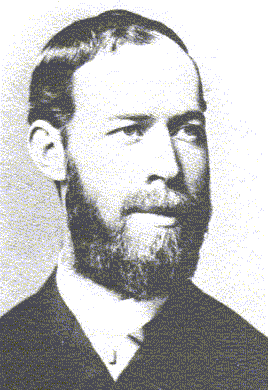 Heinrich Hertz, a German physicist who was born in 1857 and died of
blood poisoning in 1894 at the age of 37, applied Maxwell's
theories to the production and reception of radio waves. In recognition
of his work, the unit of frequency of a radio wave -- one cycle per second
-- is named the hertz, in honor of Heinrich Hertz.
Heinrich Hertz, a German physicist who was born in 1857 and died of
blood poisoning in 1894 at the age of 37, applied Maxwell's
theories to the production and reception of radio waves. In recognition
of his work, the unit of frequency of a radio wave -- one cycle per second
-- is named the hertz, in honor of Heinrich Hertz.
In 1888, in a corner of his physics classroom at the Karlsruhe Polytechnic in Berlin, Hertz generated electric waves by means of the oscillatory discharge of a condenser through a loop provided with a spark gap, and then detecting them with a similar type of circuit. Hertz's condenser was a pair of metal rods, placed end to end with a small gap for a spark between them. When these rods were given charges of opposite signs, strong enough to spark, the current would oscillate back and forth across the gap and along the rods. With this oscillator, Hertz solved two problems: 1) timing Maxwell's waves (he had demonstrated, in the concrete, what Maxwell had only theorized: that the velocity of radio waves was equal to the velocity of light), and 2) how to make the electric and magnetic fields detach themselves from wires and go free as Maxwell's waves.
Hertz's students were impressed, and wondered what use might be made of this marvelous phenomenon. But Hertz thought his discoveries were no more practical than Maxwell's. "It's of no use whatsoever," he replied. "This is just an experiment that proves Maestro Maxwell was right -- we just have these mysterious electromagnetic waves that we cannot see with the naked eye. But they are there."
"So, what next?" asked one of his students at the University of Bonn.
Hertz shrugged. He was a modest man, of no pretensions and, apparently, little ambition. "Nothing, I guess."
But, even at a theoretical level, Hertz's accomplishments were quickly seen by others as the beginning of a new "electric age." The English mathematical physicist, Sir. Oliver Heaviside, said in 1891, "Three years ago, electromagnetic waves were nowhere. Shortly afterward, they were everywhere."
Summing up Hertz's importance: his experiments dealing with the reflection, refraction, polarization, interference and velocity of electric waves would trigger the invention, soon after, of the wireless telegraph and of radio.
It happened this way: in 1888, Hertz described in an electrical journal how he was able to trigger his electromagnetic waves with his oscillator. A young man in his teens happened to read the article while he was vacationing in the Alps. For him, Hertz's discovery gave him an idea: why not use the waves set off by Hertz's spark oscillator for signaling? Guglielmo Marconi was that young man. He rushed back home to Italy to give the idea a try.
When Hertz died in Bonn, Germany, in 1894, Sir Oliver Lodge gave Hertz credit for accomplishing what the great English physicists of the time were unable to do. It was not hard to give Hertz credit. Not only had he established the validity of Maxwell's theorems, he had done so with a winning modesty. "He was a noble man," said one eulogist in 1894, "who had the singular good fortune to find many admirers, but none to hate or envy him; those who came into personal contact with him were struck by his modesty and charmed by his amiability. He was a true friend to his friends, a respected teacher to his students, who had begun to gather around him in large numbers, some of the coming from great distances; and to his family a loving husband and father."
